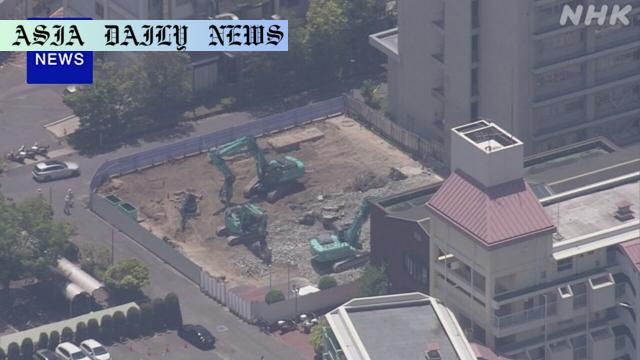Wartime Bomb: Police in Japan are investigating a potential unexploded wartime bomb found at Hiroshima University’s Kasumi campus.

Possible Discovery of a Wartime Bomb at Hiroshima University
A startling discovery unfolded on a peaceful Tuesday morning at Hiroshima University’s Kasumi campus, raising concerns about a potential relic from World War II. Workers stumbled upon what appears to be an unexploded wartime bomb at a construction site where a building had recently been demolished. The suspect object measures approximately 90 centimeters in length and 25 centimeters in diameter, prompting local police to escalate security measures.
The discovery was reported to authorities at around 10:20 a.m., leading to immediate action. Police cordoned off the area to ensure the safety of nearby students, workers, and residents. Classes at the Kasumi campus were suspended in the afternoon as a precautionary measure. However, Hiroshima University Hospital, which is situated within the same campus, continued to provide medical treatment without interruptions. The juxtaposition of an active hospital and a site of possible danger only adds to the tension and urgency surrounding the situation.
Military Significance of the Kasumi Campus and Wartime Legacy
The Kasumi campus’s location holds significant historical weight, being only about two kilometers from Hiroshima Station. During World War II, this area housed military armories, making it plausible for wartime munitions to remain buried, undetected, for decades. The discovery of the unexploded bomb serves as a reminder of the extensive military activity during the war and Hiroshima’s pivotal role in those harrowing times. This is not the first time unexploded ordinance from the war has been uncovered in urban Japan, but the proximity of this device to a bustling university campus escalates its importance.
Authorities have called in Ground Self-Defense Force personnel to handle the situation. Their expertise is vital not only for safely removing the device but also determining its origins and the risks associated with it. As more information unfolds, questions surrounding the long-term implications of similar discoveries in historically significant locations remain pertinent. How can urban development and preserving human safety coexist in such areas with wartime histories?
Reflection on Hiroshima and Its Journey Forward
The discovery of the bomb inevitably stirs emotions considering its setting—Hiroshima, a city synonymous with peace-building after enduring one of the most catastrophic events in modern history. For Hiroshima residents, the city is not merely a relic of its tragic past but also a symbol of resilience and a beacon for global peace. The uncovering of this wartime remnant evokes parallels between historical legacies and present-day progress.
Today, Hiroshima serves as an emblem of recovery, housing institutions that lead innovation and learning. However, events like this underline the lingering presence of war’s physical—and emotional—scars. The event serves as a poignant reminder for continued dedication to educating humanity about past conflicts and striving for a world where war and its remnants do not have a place.
Commentary
Reflection on the Historical and Present-Day Impact
The discovery of a possible wartime bomb on Hiroshima University’s campus offers both a moment of reflection and a reminder of our collective past. Hiroshima, as a city, bears a unique significance in global history due to its role in World War II—a history marked by indescribable tragedy but also immense resilience.
This event highlights the enduring footprint of wars long past. Despite the decades that have passed since World War II, its remnants manifest in ways both literal and symbolic. When such relics are unearthed, they remind us of the importance of peace and the value of maintaining historical consciousness. It’s fascinating yet sobering that even in areas now devoted to education and healing—such as Hiroshima University and its adjacent hospital—the echoes of the past still ripple into the present day.
Confronting the Challenges of Urban Development
Urban development in historically significant locations like Hiroshima poses unique challenges. As cities grow and evolve, so do efforts to modernize infrastructure and meet the demands of a burgeoning population. However, with this development comes the risk of unearthing remnants of a violent history. This incident calls attention to the need for careful planning and safety measures when undertaking construction in areas known for their wartime significance.
It also raises questions about the procedures in place for managing such discoveries. How equipped are urban centers with historical links to conflict in dealing with these complex situations? The swift action of local police and the Ground Self-Defense Force deserves commendation, as their response ensured public safety and minimized panic.
Reminder of Hiroshima’s Global Symbolism
Above all, this incident reaffirms Hiroshima’s position as a poignant reminder of the past. As a city that has rebuilt itself to become an advocate for peace and innovation, it continues to teach us the value of resilience and the human capacity for progress. While this discovery of an unexploded wartime bomb may initially evoke fear and concern, it should ultimately strengthen our resolve to prevent such tragedies from recurring in our global history.


